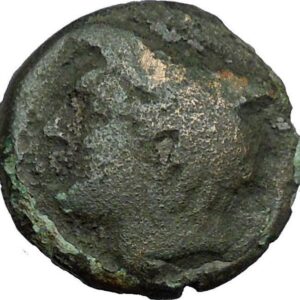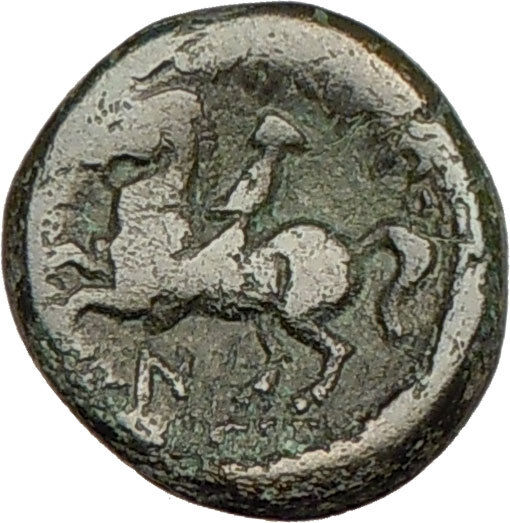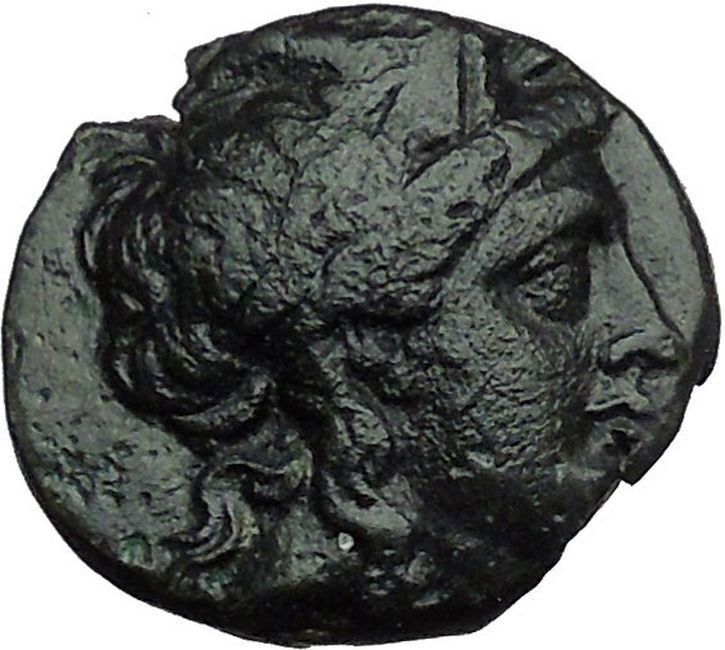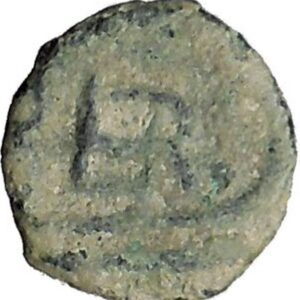|
Greek Seleucid Kingdom
Seleukos II, Kallinikos – King: 246-226 B.C.
Bronze 16mm (3.50 grams) Struck circa: 246-226 B.C.
Reference: SC 660.2; HGC 9, 345
Head of Athena right, in crested Corinthian helmet.
ΒΑΣΙΛΕΩΣ / ΣΕΛΕΥΚΟΥ
either side of Apollo standing left, testing arrow and holding
grounded bow;
monogram to outer left.
The elder son of Antiochos II and Laodike, Seleukos spent much much of his reign
in conflict with his younger brother, Antiochos Hierax, who ruled independently
in Asia Minor. Seleukos was killed by a fall from his horse after a troubled
reign of twenty years.
You are bidding on the exact item pictured,
provided with a Certificate of Authenticity and Lifetime Guarantee of
Authenticity.

Apollo Belvedere
,
ca. 120–140 CE
Apollo is one of the most important and complex of the
Olympian deities
in
ancient Greek
and
Roman religion
,
Greek
and
Roman mythology
, and
Greco
–Roman
Neopaganism
. The ideal of the
kouros
(a beardless, athletic youth),
Apollo has been variously recognized as a god of light and the sun, truth and
prophecy, healing, plague, music, poetry, and more. Apollo is the son of
Zeus and Leto
, and has a twin sister, the chaste
huntress Artemis
. Apollo is known in Greek-influenced
Etruscan mythology
as Apulu.
As the patron of Delphi
(Pythian Apollo), Apollo was an
oracular
god—the prophetic deity of the
Delphic Oracle
. Medicine and healing are
associated with Apollo, whether through the god himself or mediated through his
son Asclepius
, yet Apollo was also seen as a god
who could bring ill-health and deadly
plague
. Amongst the god’s custodial charges,
Apollo became associated with dominion over
colonists
, and as the patron defender of herds
and flocks. As the leader of the
Muses (Apollon Musegetes) and director of their choir, Apollo
functioned as the patron god of music and poetry.
Hermes
created the
lyre for him, and the instrument became a common
attribute of Apollo
. Hymns sung to Apollo were
called paeans
.
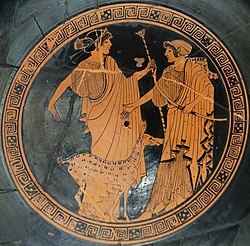
Apollo (left) and
Artemis
.
Brygos
(potter signed), Tondo of an
Attic red-figure cup c. 470 BC,
Musée du Louvre
.
In Hellenistic times, especially during the 3rd century BCE, as Apollo
Helios he became identified among Greeks with
Helios
,
Titan
god of the sun
, and his sister Artemis
similarly equated with
Selene
, Titan
goddess of the moon
In Latin texts, on the
other hand,
Joseph Fontenrose
declared himself unable to
find any conflation of Apollo with
Sol
among the
Augustan poets
of the 1st century, not even in
the conjurations of Aeneas
and
Latinus
in
Aeneid
XII (161–215). Apollo and Helios/Sol
remained separate beings in literary and mythological texts until the 3rd
century CE.
Etymology

Statuette of the Apollo Lykeios type,
Museum of the Ancient Agora of Athens
(inv. BI 236).
Apollo was worshipped throughout the
Roman Empire
. In the traditionally
Celtic
lands he was most often seen as a
healing and sun god. He was often equated with
Celtic gods
of similar character.
Apollo Atepomarus
(“the great horseman”
or “possessing a great horse”). Apollo was worshipped at
Mauvières
(Indre).
Horses were, in the Celtic world, closely linked to the sun.[23]
Apollo Belenus
(‘bright’ or
‘brilliant’). This epithet was given to Apollo in parts of
Gaul
, Northern Italy and
Noricum
(part of modern Austria). Apollo
Belenus was a healing and sun god.[24]
Apollo Cunomaglus
(‘hound lord’). A
title given to Apollo at a shrine in
Wiltshire
. Apollo Cunomaglus may have been
a god of healing. Cunomaglus himself may originally have been an independent
healing god.[25]
Apollo Grannus
. Grannus was a healing
spring god, later equated with Apollo.- Apollo Maponus. A god known from inscriptions in Britain. This
may be a local fusion of Apollo and
Maponus
.
Apollo Moritasgus
(‘masses of sea
water’). An epithet for Apollo at Alesia, where he was worshipped as god of
healing and, possibly, of physicians.
Apollo Vindonnus
(‘clear light’).
Apollo Vindonnus had a temple at
Essarois
, near
Châtillon-sur-Seine
in
Burgundy
. He was a god of healing,
especially of the eyes.
Apollo Virotutis
(‘benefactor of
mankind?’). Apollo Virotutis was worshipped, among other places, at Fins
d’Annecy (Haute-Savoie)
and at Jublains
(Maine-et-Loire).
Origins

The Omphalos
in the Museum of
Delphi
.
The cult centers of Apollo in Greece,
Delphi
and
Delos
, date from the 8th century BCE. The Delos
sanctuary was primarily dedicated to
Artemis
, Apollo’s twin sister. At Delphi,
Apollo was venerated as the slayer of
Pytho
. For the Greeks, Apollo was all the Gods
in one and through the centuries he acquired different functions which could
originate from different gods. In
archaic Greece
he was the
prophet
, the oracular god who in older times
was connected with “healing”. In
classical Greece
he was the god of light and of
music, but in popular religion he had a strong function to keep away evil.
From his eastern-origin Apollo brought the art of inspection from “symbols
and omina
” (σημεία και τέρατα : semeia kai
terata), and of the observation of the
omens of the days. The inspiration oracular-cult was probably
introduced from Anatolia
. The
ritualism
belonged to Apollo from the
beginning. The Greeks created the
legalism
, the supervision of the orders of the
gods, and the demand for moderation and harmony. Apollo became the god of
shining youth, the protector of music, spiritual-life, moderation and
perceptible order. The improvement of the old
Anatolian
god, and his elevation to an
intellectual sphere, may be considered an achievement of the
Greek
people.
Healer and
god-protector from evil
The function of Apollo as a “healer” is connected with
Paean
, the physician of the Gods in the
Iliad
, who seems to come from a more
primitive religion. Paeοn is probably connected with the
Mycenean
Pa-ja-wo, but the etymology is the
only evidence. He did not have a separate cult, but he was the personification
of the holy magic-song sung by the magicians that was supposed to cure disease.
Later the Greeks knew the original meaning of the relevant song “paean”. The
magicians were also called “seer-doctors”, and they used an ecstatic prophetic
art which was used exactly by the god Apollo at the oracles.
In the Iliad, Apollo is the healer under the gods, but he is also the
bringer of disease and death with his arrows, similar to the function of the
terrible
Vedic
god of disease
Rudra
.He sends a terrible plague to the
Achaeans
. The god who sends a disease can also
prevent from it, therefore when it stops they make a purifying ceremony and
offer him an “hecatomb” to ward off evil. When the oath of his priest appeases,
they pray and with a song they call their own god, the beautiful Paean.
Some common epithets of Apollo as a healer are “paion” , “epikourios”,
“oulios”, and “loimios” . In classical times, his strong function in popular
religion was to keep away evil, and was therefore called “apotropaios” and
“alexikakos” , throw away the evil).
In later writers, the word, usually spelled “Paean”, becomes a
mere epithet of Apollo in his capacity as a god of
healing
.
Homer illustrated Paeon the god, and the song both of
apotropaic
thanksgiving or triumph. Such songs
were originally addressed to Apollo, and afterwards to other gods: to
Dionysus
, to Apollo
Helios
, to Apollo’s son
Asclepius
the healer. About the 4th century
BCE, the paean became merely a formula of adulation; its object was either to
implore protection against disease and misfortune, or to offer thanks after such
protection had been rendered. It was in this way that Apollo had become
recognised as the god of music. Apollo’s role as the slayer of the
Python
led to his association with battle and
victory; hence it became the
Roman
custom for a paean to be sung by an army
on the march and before entering into battle, when a fleet left the harbour, and
also after a victory had been won.
Dorian origin
The connection with Dorians and their initiation festival
apellai
is reinforced by the month
Apellaios in northwest Greek calendars, but it can explain only the Doric
type of the name, which is connected with the
Ancient Macedonian
word “pella” (Pella),
stone. Stones played an important part in the cult of the god, especially
in the oracular shrine of Delphi (Omphalos).
The “Homeric hymn” represents Apollo as a Northern intruder. His arrival must
have occurred during the “dark ages” that followed the destruction of the
Mycenaean civilization
, and his conflict with
Gaia
(Mother Earth) was represented by the
legend of his slaying her daughter the serpent
Python
.
The earth deity had power over the ghostly world, and it is believed that she
was the deity behind the oracle. The older tales mentioned two dragons who were
perhaps intentionally conflated. A female dragon named
Delphyne
who is obviously connected with Delphi
and Apollo Delphinios, and a male serpent
Typhon
, the adversary of
Zeus in the
Titanomachy
, who the narrators confused with
Python
. Python was the good daemon of the
temple as it appears in
Minoan
religion, but she was represented as a
dragon, as often happens in Northern European folklore as well as in the East.
Apollo and his sister
Artemis
can bring death with their arrows. The
conception that diseases and death come from invisible shots sent by
supernatural beings, or magicians is common in
Germanic
and
Norse
mythology.[35]
In
Greek mythology
Artemis was the leader of the
nymphs
, who had similar functions with the
Nordic
Elves.The “elf-shot” originally indicated disease or death attributed
to the elves, but it was later attested denoting
arrow
-heads which were used by witches to harm
people, and also for healing rituals.
The
Vedic
Rudra has some similar functions with
Apollo. The terrible god is called “The Archer”, and the bow is also an
attribute of Shiva
. Rudra could bring diseases with his
arrows, but he was able to free people of them, and his alternative Shiba, is a
healer physician god. However the
Indo-European
component of Apollo, does not
explain his strong relation with omens, exorcisms, and with the oracular cult.
Minoan origin
It seems an oracular cult existed in Delphi from the
Mycenaean
ages.[53]
In historical times, the priests of Delphi were called
Labryaden
, “the double-axe men”, which
indicates
Minoan
origin. The double-axe (λάβρυς:labrys)
was the holy symbol of the
Cretan
labyrinth
.[54][55]
The Homeric hymn adds that Apollo appeared as a dolphin and carried Cretan
priests to Delphi, where they evidently transferred their religious practices.
Apollo Delphinios was a sea-god especially worshiped in Crete and in the
islands, and his name indicates his connection with Delphi[56]
and the holy serpent
Delphyne
(womb). Apollo’s sister
Artemis
, who was the Greek goddess of hunting,
is identified with
Britomartis
(Diktynna),
the
Minoan
“Mistress of the animals”. In her
earliest depictions she is accompanied by the “Mister of the animals”, a male
god of hunting who had the bow as his attribute. We don’t know his original
name, but it seems that he was absorbed by the more powerful Apollo, who stood
by the “Mistress of the animals”, becoming her brother.[49]
The old oracles in Delphi seem to be connected with a local tradition of the
priesthood, and there is not clear evidence that a kind of inspiration-prophecy
existed in the temple. This led some scholars to the conclusion that Pythia
carried on the rituals in a consistent procedure through many centuries,
according to the local tradition. In that regard, the mythical seeress
Sibyl
of
Anatolian
origin, with her ecstatic art, looks
unrelated to the oracle itself.[57]
However, the Greek tradition is referring to the existence of vapours and
chewing of laurel-leaves, which seem to be confirmed by recent studies.[58]
Plato
describes the priestesses of Delphi and
Dodona
as frenzied women, obsessed by “mania” (μανία:frenzy),
a Greek word connected with “mantis” (μάντις:prophet). Frenzied women like
Sibyls from whose lips the god speaks are recorded in the
Near East
as
Mari
in the second millennium BC.[59]
Although Crete had contacts with Mari from 2000 BC,[60]
there is no evidence that the ecstatic prophetic art existed during the Minoan
and Mycenean ages. It is more probable that this art was introduced later from
Anatolia
and regenerated an existing oracular
cult that was local to Delphi and dormant in several areas of Greece.[61]
Anatolian origin
A non-Greek origin of Apollo has long been assumed in scholarship.[3]
The name of Apollo’s mother
Leto has Lydian
origin, and she was worshipped on the
coasts of
Asia Minor
. The inspiration oracular cult was
probably introduced into Greece from
Anatolia
, which is the origin of
Sibyl
, and where existed some of the oldest
oracular shrines. Omens, symbols, purifications, and exorcisms appear in old
Assyro
–Babylonian
texts, and these rituals were spread into the empire of the
Hittites
. In a Hittite text is mentioned that
the king invited a Babylonian priestess for a certain “purification”.[33]
A similar story is mentioned by
Plutarch
. He writes that the
Cretan
–
seer
Epimenides
, purified
Athens
after the pollution brought by the
Alcmeonidae
, and that the seer’s expertise in
sacrifices
and reform of funeral practices were
of great help to Solon
in his reform of the Athenian state.[62]
The story indicates that Epimenides was probably heir to the shamanic religions
of Asia, and proves together with the
Homeric
hymn, that Crete had a resisting
religion up to the historical times. It seems that these rituals were dormant in
Greece, and they were reinforced when the Greeks migrated to
Anatolia
.
Homer
pictures Apollo on the side of the
Trojans, fighting against the
Achaeans
, during the
Trojan War
. He is pictured as a terrible god,
less trusted by the Greeks than other gods. The god seems to be related to
Appaliunas, a tutelary god of
Wilusa
(Troy)
in Asia Minor, but the word is not complete.[63]
The stones found in front of the gates of
Homeric
Troy were the symbols of Apollo. The
Greeks gave to him the name αγυιεύς
agyieus
as the protector god of public places
and houses who wards off evil, and his symbol was a tapered stone or column.[64]
However, while usually Greek festivals were celebrated at the
full moon
, all the feasts of Apollo were
celebrated at the seventh day of the month, and the emphasis given to that day (sibutu)
indicates a
Babylonian
origin.[65]
The
Late Bronze Age
(from 1700 to 1200 BCE)
Hittite
and
Hurrian
Aplu was a god of
plague
, invoked during plague years. Here we
have an
apotropaic
situation, where a god originally
bringing the plague was invoked to end it. Aplu, meaning the son of, was
a title given to the god
Nergal
, who was linked to the
Babylonian
god of the sun
Shamash
.[12]
Homer interprets Apollo as a terrible god (δεινός θεός) who brings death and
disease with his arrows, but who can also heal, possessing a magic art that
separates him from the other Greek gods.[66]
In Iliad
, his priest prays to Apollo
Smintheus,[67]
the mouse god who retains an older agricultural function as the protector from
field rats.[68][69]
All these functions, including the function of the healer-god
Paean
, who seems to have Mycenean origin, are
fused in the cult of Apollo.
Oracular cult

Columns of the
Temple of Apollo
at Delphi, Greece.
Unusually among the Olympic deities, Apollo had two cult sites that had
widespread influence: Delos
and
Delphi
. In cult practice,
Delian Apollo
and
Pythian Apollo
(the Apollo of Delphi) were so
distinct that they might both have shrines in the same locality.[70]
Apollo’s
cult
was already fully established when written
sources commenced, about 650 BCE. Apollo became extremely important to the Greek
world as an oracular deity in the
archaic period
, and the frequency of
theophoric names
such as Apollodorus or
Apollonios and cities named Apollonia testify to his popularity.
Oracular sanctuaries to Apollo were established in other sites. In the 2nd and
3rd century CE, those at
Didyma
and
Clarus
pronounced the so-called “theological
oracles”, in which Apollo confirms that all deities are aspects or servants of
an
all-encompassing, highest deity
. “In the 3rd
century, Apollo fell silent.
Julian the Apostate
(359 – 61) tried to revive
the Delphic oracle, but failed
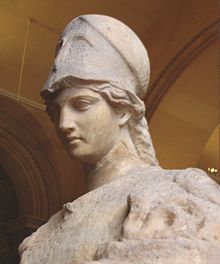
Helmeted Athena with the cista and Erichthonius in his serpent form.
Roman, first century (Louvre
Museum)
In
Greek religion
and
mythology
, Athena or Athene, also
referred to as Pallas Athena/Athene , is the goddess of wisdom, courage,
inspiration, civilization, law and justice, just warfare, mathematics, strength,
strategy, the arts, crafts, and skill.
Minerva
is the
Roman goddess
identified with
Athena.
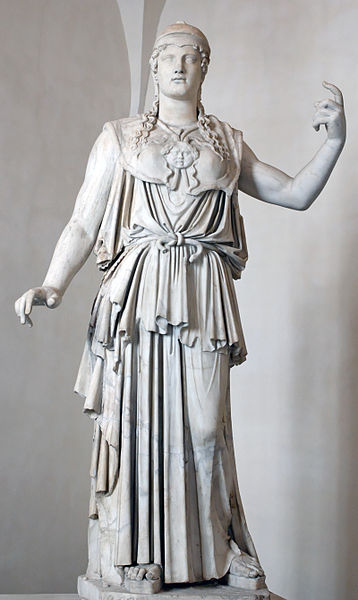
Marble Greek copy signed “Antiokhos”, a first century BC variant of
Phidias
‘
fifth-century
Athena Promachos
that stood on the
Acropolis
Athena is also a shrewd companion of
heroes and is the
goddess
of heroic endeavour. She is the
virgin
patroness of
Athens
. The Athenians founded the
Parthenon
on the Acropolis of her namesake
city, Athens (Athena Parthenos), in her honour.
Athena’s veneration as the patron of Athens seems to have existed from the
earliest times, and was so persistent that archaic myths about her were recast
to adapt to cultural changes. In her role as a protector of the city (polis),
many people throughout the Greek world worshiped Athena as Athena Polias
(Ἀθηνᾶ Πολιάς “Athena of the city”). The city of
Athens
and the goddess Athena essentially bear
the same name, “Athenai” meaning “[many] Athenas”.
Origin traditions
The Greek philosopher
Plato
(429–347 BC) identified her with the
Libyan
deity
Neith
, the war goddess and huntress deity of
the Egyptians since the ancient Pre-Dynastic period, who was also identified
with weaving
. This is sensible, as some Greeks
identified Athena’s birthplace, in certain mythological renditions, as being
beside Libya’s Triton River in North Africa.[6]
Scholar
Martin Bernal
created the controversial
Black Athena
Theory to explain this associated
origin by claiming that the conception of
Neith
was brought to Greece from Egypt, along
with “an enormous number of features of civilization and culture in the third
and second millennia.”
Patroness
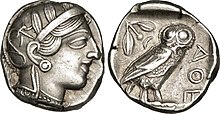
Athenian
tetradrachm
representing the
goddess Athena
Athena as the goddess of philosophy became an aspect of the cult in Classical
Greece during the late 5th century BC.She is the patroness of various crafts,
especially of weaving
, as Athena Ergane, and was
honored as such at festivals such as
Chalceia
. The metalwork of weapons also fell
under her patronage. She led battles (Athena
Promachos or the warrior maiden Athena Parthenos) as the
disciplined, strategic side of war, in contrast to her brother
Ares, the patron of violence, bloodlust and slaughter—”the raw force
of war”. Athena’s wisdom includes the cunning intelligence (metis) of
such figures as Odysseus
. Not only was this version of Athena
the opposite of Ares in combat, it was also the polar opposite of the serene
earth goddess version of the deity, Athena Polias.
Athena appears in Greek mythology as the patron and helper of many heroes,
including Odysseus
,
Jason
, and
Heracles
. In
Classical Greek
myths, she never consorts with
a lover, nor does she ever marry,earning the title Athena Parthenos. A
remnant of archaic myth depicts her as the adoptive mother of
Erechtheus
/Erichthonius
through the foiled rape by
Hephaestus
. Other variants relate that
Erichthonius, the serpent that accompanied Athena, was born to
Gaia
: when the rape failed, the semen landed on
Gaia and impregnated her. After Erechthonius was born, Gaia gave him to Athena.
Though Athena is a goddess of war strategy, she disliked fighting without
purpose and preferred to use wisdom to settle predicaments.The goddess only
encouraged fighting for a reasonable cause or to resolve conflict. As patron of
Athens she fought in the Trojan war on the side of the Achaeans.
Mythology
Birth
Olympian version
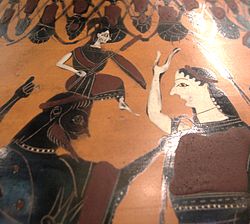
After he swallowed her pregnant mother,
Metis
, Athena is “born” from Zeus’
forehead as he grasps the clothing of
Eileithyia
on the right —black-figured
amphora
, 550–525 BC, Louvre.
Although Athena appears before
Zeus at
Knossos
—in
Linear B
, as, “Mistress Athena”[16]—in
the Classical
Olympian pantheon
, Athena was remade as the
favorite daughter of Zeus, born fully armed from his forehead. The story of her
birth comes in several versions. In the one most commonly cited, Zeus lay with
Metis, the goddess of crafty thought and wisdom, but he immediately feared the
consequences. It had been prophesied that Metis would bear children more
powerful than the sire, even Zeus himself. In order to forestall these dire
consequences, after lying with Metis, Zeus “put her away inside his own belly;”
he “swallowed her down all of a sudden.” He was too late: Metis had already
conceived.
Eventually Zeus experienced an enormous headache;
Prometheus
,
Hephaestus
,
Hermes
,
Ares, or Palaemon (depending on the sources examined) cleaved Zeus’s
head with the double-headed
Minoan
axe,
the labrys
. Athena leaped from Zeus’s head,
fully grown and armed, with a shout— “and pealed to the broad sky her clarion
cry of war. And Ouranos trembled to hear, and Mother Gaia…” (Pindar,
Seventh Olympian Ode). Plato, in the
Laws
, attributes the cult of Athena to the
culture of Crete
, introduced, he thought, from Libya
during the dawn of Greek culture.
Classical myths thereafter note that
Hera was so annoyed at Zeus for having produced a child that she
conceived and bore
Hephaestus
by
herself
.
Plato, in
Cratylus
(407B) gave the etymology of her
name as signifying “the mind of god”, theou noesis. The Christian
apologist of the 2nd century
Justin Martyr
takes issue with those pagans who
erect at springs images of
Kore
, whom he interprets as Athena:
“They said that Athena was the daughter of Zeus not from intercourse, but
when the god had in mind the making of a world through a word (logos)
his first thought was Athena”.
Other origin tales
Some origin stories tell of Athena having been born outside of Olympus and
raised by the god Triton. Fragments attributed by the Christian
Eusebius of Caesarea
to the semi-legendary
Phoenician
historian
Sanchuniathon
, which Eusebius thought had been
written before the
Trojan war
, make Athena instead the daughter of
Cronus
, a king of
Byblos
who visited ‘the inhabitable world’ and
bequeathed Attica
to Athena. Sanchuniathon’s account would
make Athena the sister of Zeus and Hera, not Zeus’ daughter.
Pallas Athena
The major competing tradition regarding Athena’s parentage involves some of
her more mysterious
epithets
: Pallas, as in the ancient-Greek
Παλλάς Άθήνη (also Pallantias) and
Tritogeneia (also Trito, Tritonis, Tritoneia, Tritogenes). A distant archaic
separate entity named
Pallas
is invoked as Athena’s father, sister,
foster sister, companion, or opponent in battle. Pallas is often a nymph, a
daughter of
Triton
(a sea god), and a childhood friend of
Athena.
In every case, Athena kills Pallas, accidentally, and thereby gains the name
for herself. In one telling, they practice the arts of war together until one
day they have a falling out. As Pallas is about to strike Athena, Zeus
intervenes. With Pallas stunned by a blow from Zeus, Athena takes advantage and
kills her. Distraught over what she has done, Athena takes the name Pallas for
herself.
When Pallas is Athena’s father the events, including her birth, are located
near a body of water named Triton or
Tritonis
. When Pallas is Athena’s sister or
foster-sister, Athena’s father or foster-father is
Triton
, the son and herald of
Poseidon
. But Athena may be called the daughter
of Poseidon and a nymph named Tritonis, without involving Pallas. Likewise,
Pallas may be Athena’s father or opponent, without involving Triton. On this
topic, Walter Burkert says “she is the Pallas of Athens, Pallas Athenaie,
just as Hera of Argos is Here Argeie. For the Athenians, Burkert notes,
Athena was simply “the Goddess”, hē theós, certainly an ancient title.
Athena
Parthenos: Virgin Athena
Athena never had a consort or lover and is thus known as
Athena Parthenos
, “Virgin Athena”. Her most
famous temple, the
Parthenon
, on the
Acropolis
in
Athens
takes its name from this title. It is
not merely an observation of her virginity, but a recognition of her role as
enforcer of rules of sexual modesty and ritual mystery. Even beyond recognition,
the Athenians allotted the goddess value based on this pureness of virginity as
it upheld a rudiment of female behavior in the patriarchal society. Kerenyi’s
study and theory of Athena accredits her virginal toponym to be a result of the
relationship to her father Zeus and a vital, cohesive piece of her character
throughout the ages.
This role is expressed in a number of stories about Athena.
Marinus of Neapolis
reports that when
Christians removed the statue of the Goddess from the
Parthenon
, a beautiful woman appeared in a
dream to Proclus
, a devotee of Athena, and announced
that the “Athenian Lady” wished to dwell with him.
Erichthonius
Hephaestus
attempted to
rape Athena, but she eluded him. His
semen
fell to the earth and impregnated the
soil, and
Erichthonius
was born from the Earth,
Gaia
. Athena then raised the baby as a foster
mother.
Athena puts the infant Erichthonius into a small box (cista) which she
entrusts to the care of three sisters,
Herse
,
Pandrosus
, and
Aglaulus
of Athens. The goddess does not tell
them what the box contains, but warns them not to open it until she returns. One
or two sisters opens the cista to reveal Erichthonius, in the form (or
embrace) of a
serpent
. The serpent, or insanity induced by
the sight, drives Herse and Aglaulus to throw themselves off the
Acropolis
. Jane Harrison (Prolegomena)
finds this to be a simple cautionary tale directed at young girls carrying the
cista in the
Thesmophoria
rituals, to discourage them from
opening it outside the proper context.
Another version of the myth of the Athenian maidens is told in
Metamorphoses
by the Roman poet
Ovid (43 BC – 17 AD); in this late variant
Hermes
falls in love with Herse. Herse,
Aglaulus, and Pandrosus go to the temple to offer sacrifices to Athena. Hermes
demands help from Aglaulus to seduce Herse. Aglaulus demands money in exchange.
Hermes gives her the money the sisters have already offered to Athena. As
punishment for Aglaulus’s greed, Athena asks the goddess
Envy
to make Aglaulus jealous of Herse. When
Hermes arrives to seduce Herse, Aglaulus stands in his way instead of helping
him as she had agreed. He turns her to stone.
With this mythic origin, Erichthonius became the founder-king
of Athens, and many beneficial changes to Athenian culture were
ascribed to him. During this time, Athena frequently protected him.
Medusa and Tiresias
In a late myth, Medusa
, unlike her sister Gorgons, came to be
viewed by the Greeks of the 5th century as a beautiful mortal that served as
priestess in Athena’s temple. Poseidon liked Medusa, and decided to rape her in
the temple of Athena, refusing to allow her vow of chastity to stand in his
way.Upon discovering the desecration of her temple, Athena changed Medusa’s form
to match that of her sister Gorgons as punishment. Medusa’s hair turned into
snakes, her lower body was transformed also, and meeting her gaze would turn any
living man to stone. In the earliest myths, there is only one
Gorgon
, but there are two snakes that form a
belt around her waist.
In one version of the
Tiresias
myth, Tiresias stumbled upon Athena
bathing, and he was struck blind by her to ensure he would never again see what
man was not intended to see. But having lost his eyesight, he was given a
special gift—to be able to understand the language of the birds (and thus to
foretell the future).
Lady of Athens
Athena competed with
Poseidon
to be the patron deity of Athens,
which was yet unnamed, in a version of one
founding myth
. They agreed that each would give
the Athenians one gift and that the Athenians would choose the gift they
preferred. Poseidon struck the ground with his
trident
and a salt water spring sprang up; this
gave them a means of trade and water—Athens at its height was a significant sea
power, defeating the
Persian
fleet at the
Battle of Salamis
—but the water was salty and
not very good for drinking.
Athena, however, offered them the first domesticated
olive tree
. The Athenians (or their king,
Cecrops
) accepted the olive tree and with it
the patronage of Athena, for the olive tree brought wood, oil, and food.
Robert Graves
was of the opinion that
“Poseidon’s attempts to take possession of certain cities are political myths”
which reflect the conflict between matriarchal and patriarchal religions.
Other sites of cult
Athena also was the patron goddess of several other Greek cities, notably
Sparta, where the archaic cult of
Athena Alea
had its sanctuaries in the
surrounding villages of
Mantineia
and, notably,
Tegea
. In Sparta itself, the temple of Athena
Khalkíoikos (Athena “of the Brazen House”, often
latinized
as Chalcioecus) was the
grandest and located on the Spartan acropolis; presumably it had a roof of
bronze. The forecourt of the Brazen House was the place where the most solemn
religious functions in Sparta took place.
Tegea was an important religious center of ancient Greece, containing the
Temple of Athena Alea
. The temenos was founded by
Aleus
,
Pausanias
was informed. Votive bronzes at the
site from the Geometric and Archaic periods take the forms of horses and deer;
there are
sealstone
and
fibulae
. In the Archaic period the nine
villages that underlie Tegea banded together in a
synoecism
to form one city. Tegea was listed in
Homer
‘s
Catalogue of Ships
as one of the cities that
contributed ships and men for the
Achaean assault on Troy
.
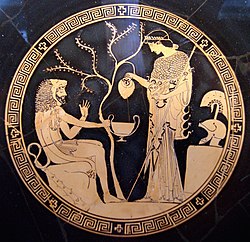
Athena and Herakles on an
Attic
red-figure
kylix
, 480–470 BC.
Counselor
Later myths of the Classical Greeks relate that Athena guided
Perseus
in his quest to behead
Medusa
. She instructed
Heracles
to skin the
Nemean Lion
by using its own claws to cut
through its thick hide. She also helped Heracles to defeat the
Stymphalian Birds
, and to navigate the
underworld so as to capture
Cerberus
.
In
The Odyssey
,
Odysseus
‘ cunning and shrewd nature quickly won
Athena’s favour. In the realistic epic mode, however, she largely is confined to
aiding him only from afar, as by implanting thoughts in his head during
his journey home from Troy. Her guiding actions reinforce her role as the “protectress
of heroes” or as mythologian
Walter Friedrich Otto
dubbed her the “goddess
of nearness” due to her mentoring and motherly probing. It is not until he
washes up on the shore of an island where
Nausicaa
is washing her clothes that Athena
arrives personally to provide more tangible assistance. She appears in
Nausicaa’s dreams to ensure that the princess rescues Odysseus and plays a role
in his eventual escort to Ithaca.
Athena appears in disguise to Odysseus upon his arrival, initially lying and
telling him that Penelope, his wife, has remarried and that he is believed to be
dead; but Odysseus lies back to her, employing skillful prevarications to
protect himself. Impressed by his resolve and shrewdness, she reveals herself
and tells him what he needs to know in order to win back his kingdom. She
disguises him as an elderly man or beggar so that he cannot be noticed by the
suitors or Penelope, and helps him to defeat the suitors.
She also plays a role in ending the resultant feud against the suitors’
relatives. She instructs Laertes to throw his spear and to kill the father of
Antinous, Eupeithes.
Judgment of Paris

Aphrodite is being surveyed by Paris, while Athena (the leftmost
figure) and Hera stand nearby.
El Juicio de Paris
by
Enrique Simonet
, ca. 1904
All the gods and goddesses as well as various mortals were invited to the
marriage of Peleus
and
Thetis
(the eventual parents of
Achilles
). Only
Eris
, goddess of discord, was not invited. She
was annoyed at this, so she arrived with a golden apple inscribed with the word
καλλίστῃ (kallistēi, “for the fairest”), which she threw among the goddesses.
Aphrodite, Hera, and Athena all claimed to be the fairest, and thus the rightful
owner of the apple.
The goddesses chose to place the matter before Zeus, who, not wanting to
favor one of the goddesses, put the choice into the hands of Paris, a
Trojan prince. After bathing in the spring of
Mount Ida
(where Troy was situated), the
goddesses appeared before Paris. The goddesses undressed and presented
themselves to Paris naked, either at his request or for the sake of winning.

Paris is awarding the apple to Aphrodite, while Athena makes a face.
Urteil des Paris by
Anton Raphael Mengs
, ca. 1757
Still, Paris could not decide, as all three were ideally beautiful, so they
resorted to bribes. Hera tried to bribe Paris with control over all
Asia and Europe
, while Athena offered wisdom, fame and
glory in battle, but Aphrodite came forth and whispered to Paris that if he were
to choose her as the fairest he would have the most beautiful mortal woman in
the world as a wife, and he accordingly chose her. This woman was
Helen
, who was, unfortunately for Paris,
already married to King
Menelaus
of
Sparta
. The other two goddesses were enraged by
this and through Helen’s abduction by Paris they brought about the
Trojan War
.
Roman fable of Arachne
The fable
of
Arachne
is a late Roman addition to Classical
Greek mythology
but does not appear in the myth
repertoire of the Attic vase-painters. Arachne’s name simply means spider
(αράχνη). Arachne was the daughter of a famous dyer in
Tyrian purple
in Hypaipa of
Lydia
, and a weaving student of Athena. She
became so conceited of her skill as a weaver that she began claiming that her
skill was greater than that of Athena herself.
Athena gave Arachne a chance to redeem herself by assuming the form of an old
woman and warning Arachne not to offend the deities. Arachne scoffed and wished
for a weaving contest, so she could prove her skill.
Athena wove the scene of her victory over
Poseidon
that had inspired her patronage of
Athens. According to Ovid’s Latin narrative, Arachne’s tapestry featured
twenty-one episodes of the infidelity of the deities, including
Zeus being unfaithful with
Leda
, with
Europa
, and with
Danaë
. Athena admitted that Arachne’s work was
flawless, but was outraged at Arachne’s offensive choice of subjects that
displayed the failings and transgressions of the deities. Finally, losing her
temper, Athena destroyed Arachne’s tapestry and loom, striking it with her
shuttle.
Athena then struck Arachne with her staff, which changed her into a spider.
In some versions, the destruction of her loom leads Arachne to hang herself in
despair; Athena takes pity on her, and transforms her into a spider. In the
aforementioned version, Arachne weaved scenes of joy while Athena weaved scenes
of horror.
The fable suggests that the origin of weaving lay in imitation of spiders and
that it was considered to have been perfected first in
Asia Minor
.
Cult and attributes
Athena’s epithets
include
Άτρυτώνη, Atrytone (= the
unwearying), Παρθένος, Parthénos
(= virgin), and Ή Πρόμαχος, Promachos
(the First Fighter, i.e. she who fights in front).
In poetry from Homer, an oral tradition of the eighth or seventh century BC,
onward, Athena’s most common
epithet
is glaukopis (γλαυκώπις), which
usually is translated as, bright-eyed or with gleaming eyes.The
word is a combination of glaukos (γλαύκος, meaning gleaming,
silvery, and later, bluish-green or gray) and ops (ώψ,
eye, or sometimes, face). It is interesting to note that glaux
(γλαύξ, “owl”) is from the same root, presumably because of the bird’s own
distinctive eyes. The bird which sees well in the night is closely associated
with the goddess of wisdom
: in archaic images, Athena is frequently
depicted with an owl named the
Glaucus
(or “owl of Athena” and later under the
Roman Empire
, “owl of
Minerva
“) perched on her hand. This pairing
evolved in tangent so that even in present day the owl is upheld as a symbol of
perspicacity and erudition.
Unsurprisingly, the owl became a sort of Athenian mascot. The
olive
tree is likewise sacred to her. In
earlier times, Athena may well have been a
bird goddess
, similar to the unknown goddess
depicted with owls, wings, and bird talons on the
Burney relief
, a Mesopotamian terracotta relief
of the early second millennium BC.
Other epithets include: Aethyta under which she was worshiped in
Megara
. The word aithyia (αἴθυια)
signifies a diver, and figuratively, a ship, so the name must
reference Athena teaching the art of shipbuilding or navigation.In a temple at
Phrixa in Elis
, which was reportedly built by Clymenus,
she was known as Cydonia.
The various Athena subgroups, or cults, all branching from the central
goddess herself often proctored various initiation rites of Grecian youth, for
example, the passage into citizenship by young men and for women the elevation
to the status of citizen wife. Her various cults were portals of a uniform
socialization, even beyond mainland Greece.
Epithets
In the Iliad
(4.514), the
Homeric Hymns
, and in
Hesiod
‘s
Theogony
, Athena is given the curious
epithet Tritogeneia. The meaning of this term is unclear. It seems to
mean “Triton-born”,
perhaps indicating that the sea-deity was her parent according to some early
myths. In Ovid’s Metamorphoses Athena is occasionally referred to as “Tritonia”.
Another possible meaning may be triple-born or third-born,
which may refer to a triad or to her status as the third daughter of Zeus or the
fact she was born from Metis, Zeus, and herself; various legends list her as
being the first child after Artemis and Apollo, though other legends identify
her as Zeus’ first child. The latter would have to be drawn from Classical
myths, however, rather than earlier ones.
In her role as judge at
Orestes’
trial on the murder of his mother,
Clytemnestra
(which he won), Athena won the
epithet Athena Areia.
Other epithets were
Ageleia
and
Itonia
.

The Parthenon
, Temple of Athena
Parthenos
Athena was given many other cult titles. She has the epithet Athena Ergane
as the patron of craftsmen and artisans. With the epithet
Athena Parthenos
(“virgin”) she was
especially worshipped in the festivals of the
Panathenaea
and
Pamboeotia
where both militaristic and athletic
displays took place.[45]
With the epithet
Athena Promachos
she led in battle (see
Promachos
). With the epithet Athena Polias
(“of the city”), Athena was the protector of not only Athens but also of many
other cities, including
Argos
,
Sparta
,
Gortyn
,
Lindos
, and
Larisa
.
She was given the epithet
Athena Hippeia
or Athena Hippia
(“horse”), as the inventor of the
chariot
, and was worshiped under this title at
Athens, Tegea
and
Olympia
. As Athena Hippeia she was given an
alternative parentage:
Poseidon
and
Polyphe
, daughter of
Oceanus
.In each of these cities her temple
frequently was the major temple on the acropolis.Athena often was equated with
Aphaea
, a local goddess of the island of
Aegina
, located near
Athens
, once Aegina was under Athenian’s power.
The Greek historian
Plutarch
(46–120 AD) also refers to an instance
during the Parthenon’s construction of her being called Athena
Hygieia
(“healer”):
A strange accident happened in the course of building, which showed that
the goddess was not averse to the work, but was aiding and co-operating
to bring it to perfection. One of the artificers, the quickest and the
handiest workman among them all, with a slip of his foot fell down from
a great height, and lay in a miserable condition, the physicians having
no hope of his recovery. When
Pericles
was in distress about this,
the goddess [Athena] appeared to him at night in a dream, and ordered a
course of treatment, which he applied, and in a short time and with
great ease cured the man. And upon this occasion it was that he set up a
brass statue of Athena Hygeia, in the citadel near the altar, which they
say was there before. But it was
Phidias
who wrought the goddess’s image
in gold, and he has his name inscribed on the pedestal as the workman of
it.
In classical times the
Plynteria
, or “Feast of Adorning”, was observed
every May, it was a festival lasting five days. During this period the
Priestesses of Athena, or “Plyntrides”, performed a cleansing ritual within “the
Erecththeum”, the personal sanctuary of the goddess. Here Athena’s statue was
undressed, her clothes washed, and body purified.
In Arcadia
, she was assimilated with the ancient
goddess Alea and worshiped as
Athena Alea
.
In Classical art

The
Athena Giustiniani
, a Roman
copy of a Greek statue of Pallas Athena with her serpent,
Erichthonius
Classically, Athena is portrayed wearing a full- length
chiton
, and sometimes in armor, with her helmet
raised high on the forehead to reveal the image of
Nike
. Her shield bears at its centre the aegis
with the head of the gorgon (gorgoneion) in the center and snakes around the
edge. It is in this standing posture that she was depicted in
Phidias
‘s famous lost
gold and ivory
statue of her, 36 m tall, the
Athena Parthenos
in the
Parthenon
. Athena also often is depicted with
an
owl sitting on one of her shoulders.[50]
The
Mourning Athena
is a relief sculpture that
dates around 460 BC and portrays a weary Athena resting on a staff. In earlier,
archaic portraits of Athena in
Black-figure pottery
, the goddess retains some
of her Minoan-Mycenaean character, such as great bird wings although this is not
true of archaic sculpture such as those of
Aphaean Athena
, where Athena has subsumed an
earlier, invisibly numinous—Aphaea—goddess
with Cretan connections in her mythos.
Other commonly received and repeated types of Athena in sculpture may be
found in
this list
.
Apart from her attributes, there seems to be a relative consensus in late
sculpture from the Classical period, the 5th century onward, as to what Athena
looked like. Most noticeable in the face is perhaps the full round strong,
masculine chin with a high nose that has a high bridge as a natural extension of
the forehead. The eyes typically are somewhat deeply set. The unsmiling lips are
usually full, but the mouth is depicted fairly narrow, usually just slightly
wider than the nose. The neck is somewhat long. The net result is a serene,
serious, somewhat aloof, and very masculine beauty.
Name,
etymology, and origin
Athena had a special relationship with
Athens
, as is shown by the etymological
connection of the names of the goddess and the city. The citizens of Athens
built a statue of Athena as a temple to the goddess, which had piercing eyes, a
helmet on her head, attired with an
aegis
or
cuirass
, and an extremely long spear. It also
had a crystal shield with the head of the Gorgon on it. A large snake
accompanied her and she held the goddess of victory in her hand.
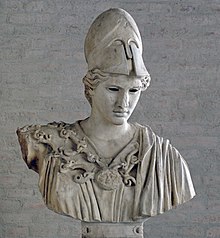
Bust of Athena in the
Glyptothek
Athena is associated with
Athens
, a plural name because it was the place
where she presided over her sisterhood, the Athenai, in earliest times:
Mycenae
was the city where the Goddess was
called Mykene, and Mycenae is named in the plural for the sisterhood of females
who tended her there. At
Thebes
she was called Thebe, and the city again
a plural, Thebae (or Thebes, where the “s” is the plural formation). Similarly,
at Athens she was called Athena, and the city Athenae (or Athens, again a
plural).”Whether her name is attested in
Eteocretan
or not will have to wait for
decipherment of Linear A
.
Günther Neumann has suggested that Athena’s name is possibly of
Lydian
origin; it may be a compound word
derived in part from
Tyrrhenian
“ati”, meaning mother and the
name of the
Hurrian
goddess “Hannahannah”
shortened in various places to “Ana”. In
Mycenaean Greek
, at
Knossos
a single inscription A-ta-na
po-ti-ni-ja /Athana potniya/ appears in the
Linear B
tablets from the Late Minoan II-era
“Room of the Chariot Tablets”; these comprise the earliest Linear B archive
anywhere.
Although Athana potniya often is translated Mistress Athena, it
literally means “the potnia of At(h)ana”, which perhaps, means the
Lady of Athens;[Any
connection to the city of Athens in the Knossos inscription is uncertain. We
also find A-ta-no-dju-wa-ja /Athana diwya/, the final part being
the Linear B spelling of what we know from Ancient Greek as Diwia :
divine Athena also was a weaver and the deity of crafts (see
dyeus
).
In his dialogue
Cratylus
, the Greek philosopher
Plato
, 428/427 BC – 348/347 BC, gives the
etymology of Athena’s name, based on the view of the ancient Athenians:
That is a graver matter, and there, my friend, the modern interpreters
of Homer may, I think, assist in explaining the view of the ancients.
For most of these in their explanations of the poet, assert that he
meant by Athena “mind” [nous]
and “intelligence” [dianoia], and the maker of names appears to
have had a singular notion about her; and indeed calls her by a still
higher title, “divine intelligence” [Theian noesis], as though he
would say: This is she who has the mind better than others. Nor shall we
be far wrong in supposing that the author of it wished to identify this
Goddess with moral intelligence [en ethei noesin], and therefore
gave her the name etheonoe; which, however, either he or his successors
have altered into what they thought a nicer form, and called her Athena.
—Plato, Cratylus, 407b
Thus for Plato her name was to be derived from Greek Ἀθεονόα, Atheonóa—which
the later Greeks rationalised as from the deity’s (theos) mind (nous).
Plato noted that the Egyptian citizens of
Sais
in Egypt worshipped a goddess whose
Egyptian name was Neith
;[58]
and they identified her with Athena. (Timaeus
21e), (Histories
2:170–175).
Some authors[citation
needed] believe that, in early times, Athena was
either an owl
herself or a
bird goddess
in general: in Book 3 of the
Odyssey
, she takes the form of a
sea-eagle
. These authors argue that she dropped
her prophylactic owl-mask before she lost her wings. “Athena, by the time she
appears in art,” Jane Ellen Harrison had remarked, “has completely shed her
animal form, has reduced the shapes she once wore of snake and bird to
attributes, but occasionally in
black-figure vase-paintings
she still appears
with wings.”Some Greek authors have derived natural symbols from the
etymological roots of Athena’s names to be aether, air, earth, and moon. This
was one of the primary developments of scholarly exploration in the ancient
world.
Post-classical culture

A
neoclassical
variant of
Athena Promachos
stands in
front of the
Austrian Parliament Building
in
Vienna.
A brief summary of Athena’s evolution of myriad motifs after her dominance in
Greece may be seen as follows: The rise of Christianity in Greece largely ended
the worship of Greek deities and polytheism in general, but she resurfaced in
the Middle Ages as a defender of sagacity and virtue so that her masculine
warrior status was still intact. (She may be found on some family crests of
nobility.) During the Renaissance she donned the mantle of patron of the arts
and human endeavor and finally although not ultimately, Athena personified the
miracles of freedom and republic during the French Revolution. (A statue of the
goddess was centered on the Place de la Revolution in Paris.)
For over a century
a full-scale replica of the Parthenon
has stood
in
Nashville, Tennessee
, which is known as the
Athens of the South. In 1990, a gilded 41 feet (12.5 m) tall
replica of Phidias’ statue
of Athena Parthenos
was added. The state
seal of California
features an image of Athena
(or Minerva) kneeling next to a brown grizzly bear.
Athena is a natural patron of universities: she is the symbol of the
Darmstadt University of Technology
, in Germany,
and the
Federal University of Rio de Janeiro
, in
Brazil. Her image can be found in the shields of the Faculty of Philosophy and
Letters and the Faculty of Sciences of the
National Autonomous University of Mexico
, where
her owl is the symbol of the Faculty of Chemistry. At
Bryn Mawr College
in Pennsylvania a statue of
Athena (a replica of the original bronze one in the arts and archaeology
library) resides in the Great Hall. It is traditional at exam time for students
to leave offerings to the goddess with a note asking for good luck, or to repent
for accidentally breaking any of the college’s numerous other traditions.
Athena’s owl also serves as the mascot of the college, and one of the college
hymns is “Pallas Athena”. Pallas Athena is the tutelary goddess of the
international social fraternity
Phi Delta Theta
. Her owl is also a symbol of
the fraternity.
The title character in
Edgar Allan Poe
‘s
The Raven
famously sits upon “a Bust of
Pallas”.
Athena’s Helmet is the central feature on the
United States Military Academy
crest
.
Athena is reported as a source of influence for feminist theologians such as
Carol P. Christ
.
Jean Boucher
‘s statue of the seated skeptical
thinker Ernest Renan
, shown to the left, caused great
controversy when it was installed in Tréguier,
Brittany
in 1902. Renan’s 1862 biography of
Jesus had denied his divinity, and he had written the “Prayer
on the Acropolis” addressed to the goddess Athena. The statue was
placed in the square fronted by the cathedral. Renan’s head was turned away from
the building, while Athena, beside him, was depicted raising her arm, which was
interpreted as indicating a challenge to the church during an anti-clerical
phase in French official culture. The installation was accompanied by a mass
protest from local Roman Catholics and a religious service against the growth of
skepticism
and
secularism
.
Athena has been used numerous times as a symbol of a republic by different
countries and appears on currency as she did on the ancient
drachma
of Athens. Athena (Minerva) is the
subject of the $50 1915-S Panama-Pacific
commemorative coin
. At 2.5 troy oz (78 g) gold,
this is the largest (by
weight
) coin ever produced by the
U.S. Mint
. This was the first $50 coin issued
by the U.S. Mint and no higher was produced until the production of the $100
platinum coins in 1997. Of course, in terms of face-value in adjusted dollars,
the 1915 is the highest denomination ever issued by the U.S. Mint.
Athena was depicted on the
obverse
of the Greek 100
drachmas
banknote of 1978-2001.[64]
Another recent example is the
60 Years of the Second Republic commemorative coin
issued by Austria in 2005. Athena is depicted in the obverse of the coin,
representing the Austrian Republic.
She appears briefly in Disney’s
Hercules
, but has a more dominant role in
the television series.
Athena
is an active character in
Marvel Comics
‘ main continuity, the
Marvel Universe
, most recently in the
Incredible Hercules
series. She acts as a
guide to
Hercules
and his sidekick, boy genius
Amadeus Cho
.
Athena appears in
Rick Riordan
‘s
Percy Jackson & the Olympians
book series.
Her daughter, born from her head as she was from Zeus’s,
demigod
Annabeth Chase
is one of the principal
characters. Annabeth’s father found her (Annabeth) lying in a golden cradle at
the doorstep.
The Roman name for Athena is Minerva. In the video game Assassin’s Creed II,
Minerva appears in an ancient vault underneath the Vatican at the end of the
game. She explains the origin of mankind within the story to the game’s main
protagonist, Desmond Miles, through his ancestor, Ezio Auditore.
Athena appears in the television series
Stargate SG-1
when she kidnaps
Vala Mal Doran
to gain information on the
Clava Thessara Infinitas
(The Key to Infinite
Treasure).
Masculinity and
feminism
Athena had an “androgynous compromise” that allowed her traits and what she
stood for to be attributed to male and female rulers alike over the course of
history (such as Marie de’ Medici, Anne of Austria, Christina of Sweden, and
Catherine the Great)
J.J. Bachofen advocated that Athena was originally a maternal figure stable
in her security and poise but was caught up and perverted by a patriarchal
society; this was especially the case in Athens. The goddess adapted but could
very easily be seen as a god. He viewed it as “motherless paternity in the place
of fatherless maternity” where once altered, Athena’s character was to be
crystallized as that of a patriarch.
Whereas Bachofen saw the switch to paternity on Athena’s behalf as an
increase of power, Freud on the contrary perceived Athena as an “original mother
goddess divested of her power”. In this interpretation, Athena was demoted to be
only Zeus’s daughter, never allowed the expression of motherhood. Still more
different from Bachofen’s perspective is the lack of role permanency in Freud’s
view: Freud held that time and differing cultures would mold Athena to stand for
what was necessary to them.
Seleucus II Callinicus or Pogon (Greek:
Σέλευκος Β’ Καλλίνικος , the epithets meaning “beautiful victor” and “bearded”,
respectively), was a ruler of the
Hellenistic
Seleucid Empire
, who reigned from 246 to 225 BC. After the death of this
father,
Antiochus
, he was proclaimed king by his mother,
Laodice
in
Ephesos
, while her partisans at
Antioch
murdered
Berenice
and her son, another Antiochus.
This dynastic feud began the
Third Syrian War
.
Ptolemy III
, who was Berenice’s brother and the ruler of Egypt, invaded the
Seleucid Empire and marched victoriously to the Tigris or beyond. He received
the submission of the Seleucid Empire’s eastern provinces, while Egyptian fleets
swept the coast of
Asia Minor
.
Seleucus managed to maintain himself in the interior of Asia Minor. When
Ptolemy returned to Egypt, Seleucus recovered Northern Syria and the nearer
provinces of Iran
.
However,
Antiochus Hierax
, a younger brother of Seleucus, was set up as a rival in
Asia Minor against Seleucus by a party to which Laodice herself adhered.
At
Ancyra
(about 235 BC) Seleucus sustained a crushing defeat and left the
country beyond the
Taurus
to his brother and the other powers of the peninsula. Seleucus then
undertook an
anabasis
to regain
Parthia
, the
results of which came to nothing. According to some sources, he was even taken
prisoner for several years by the Parthian king. Other sources mention that he
established a peace with
Arsaces I
, who recognized his sovereignty.
In Asia Minor,
Pergamon
now rose to greatness under
Attalus I
.
Antiochus Hierax, after a failed attempt to seize his brother’s dominions when
his own were vanishing, perished as a fugitive in
Thrace
in 228
or 227 BC.
About a year later, Seleucus was killed by a fall from his horse. Seleucus II
married his cousin
Laodice II
,
by whom he had five children and among them were:
Antiochis
,
Seleucus III Ceraunus
and
Antiochus III the Great
. He was succeeded by his elder son,
Seleucus III Ceraunus
, and later by his younger son
Antiochus III the Great
.
External links
-
Seleucus II Callinicus
entry in historical sourcebook by Mahlon H. Smith
This
article incorporates text from a publication now in the
public domain
: Chisholm,
Hugh, ed (1911).
Encyclopædia Britannica
(11th ed.). Cambridge University Press.
|
Seleucus II Callinicus
Seleucid dynasty
Born:
?
Died: 225 BC |
Preceded by
Antiochus II Theos
|
Seleucid King
246–225 BC |
Succeeded by
Seleucus III Ceraunus
|
|





















